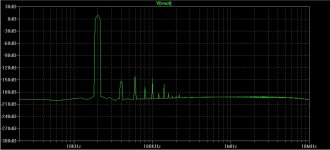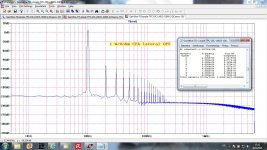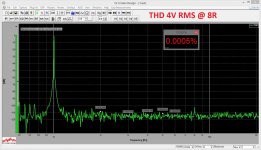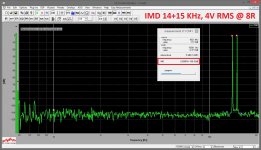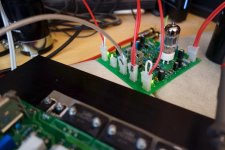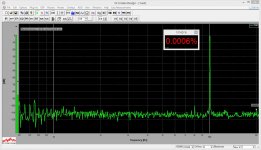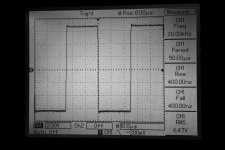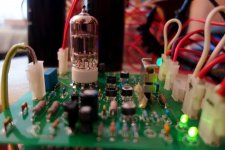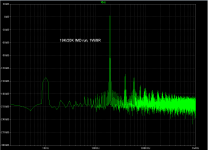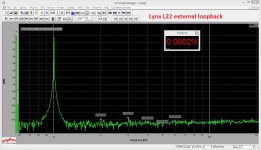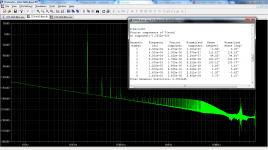This is not , "who's is longer" .... but
"who's is shorter" 😀
OS
😱
I forgot, it all about THD 😀
Blameless with BIGBT EF driver?
It is. Wolverine plus a massive EF buffered BIGBT. High power + high frequency performance isn't great though. At lower frequencies it is really good even brutally loaded down at the output, right up to clipping. Would be awesome for a low-Z subwoofer but not much else. The EF pre-drivers need to be run very hard to get reasonable performance at higher frequencies and it is still not terrific. It will likely never see the light of day.
Here is my 250W CFA. THD = 0.000037%.
Bela
This looks impressive, could you show amp schematic?
OK, my 2 cents 😉
This is not a simulation, it's a live prototype measurement.
2W @ 8R, 1 KHz
First version of my low TIM hybrid IPS + my Sanken-based OPS (3 pairs of BJTs)...
Cheers,
Valery
This is not a simulation, it's a live prototype measurement.
2W @ 8R, 1 KHz
First version of my low TIM hybrid IPS + my Sanken-based OPS (3 pairs of BJTs)...
Cheers,
Valery
Attachments
Need some THD+Noise results at these levels. SPICE does not include noise. (Does anyone know how to do this?). I think ultra low noise designs would be the way to improve SQ at 1w.
Nice achievement mate, nothing that comes above the noise floor 🙂This is not a simulation, it's a live prototype measurement.
2W @ 8R, 1 KHz
First version of my low TIM hybrid IPS + my Sanken-based OPS (3 pairs of BJTs)...
Cheers,
Valery
You think you could add a 10KHz plot too, and more so put in a description of its sound?
Need some THD+Noise results at these levels. SPICE does not include noise. (Does anyone know how to do this?). I think ultra low noise designs would be the way to improve SQ at 1w.
The right level and type of noise can enhance your hearing acuity - look up stochastic resonance.
Nice achievement mate, nothing that comes above the noise floor 🙂
You think you could add a 10KHz plot too, and more so put in a description of its sound?
Hi MagicBox,
Here are 10KHz - you can see a tiny 2-nd harmonic on the right, and 20KHz - you can't see anything, but the measurement system actually measures up to 90KHz - spectrums. At high power THD slightly increases, but stays very low (unless you're very close to clipping). I also attach a 20KHz square wave response of the front-end itself (no OPS) with the rise/fall times measured.
It sounds very nice - highest clarity at mids-highs with great separation of instruments and a powerful, tight, low-distortion bass. In fact, the biggest advantage of this design is not the low THD, but very low IMD. It handles transients with ease and this is what makes the sound so natural. Requires high quality sources (e.g. 24/192 PCM) - any source signal artifacts become noticeable.
Listening tests were performed with Monitor Audio RS8 at the output.
The design is presented in one of my threads - >HERE<
It was built by Terry (still4given), see his build >HERE<
I am also working on the new design with improved start-up behavior, cool VAS topology and potentially even higher overall characteristics - >HERE<
However, the first one is still very, very good 😉
Sorry for some advertising 😛
Cheers,
Valery
Attachments
No problem, you got quite the project there 🙂 I'd guess from the spectra alone that it does corellate to a clean, distinguishable soundstage at the mids/highs.
I've now made a 19K/20K 1W/8R IMD plot of my schematic. The IM is visible, though at around the same magnitude as the 1st even harmonic, still a good 140dB difference though. I think it'll disappear completely in any practical build where 120dB SNR is a layout achievement on its own.
I've now made a 19K/20K 1W/8R IMD plot of my schematic. The IM is visible, though at around the same magnitude as the 1st even harmonic, still a good 140dB difference though. I think it'll disappear completely in any practical build where 120dB SNR is a layout achievement on its own.
Attachments
The right level and type of noise can enhance your hearing acuity - look up stochastic resonance.
Yes aware from a signal processing prospective but still think lower noise is somewhere to go spec wise.
No problem, you got quite the project there 🙂 I'd guess from the spectra alone that it does corellate to a clean, distinguishable soundstage at the mids/highs.
I've now made a 19K/20K 1W/8R IMD plot of my schematic. The IM is visible, though at around the same magnitude as the 1st even harmonic, still a good 140dB difference though. I think it'll disappear completely in any practical build where 120dB SNR is a layout achievement on its own.
When IMD differential component (F1-F2) is comparable with the harmonics level - it's a very good result. In some designs, secondary products, like F1-(F1-F2) and F2+(F1-F2), those spikes to the left and to the right from the main frequencies, are also rather significant, but on your plot they look very good. Yes, at the practical noise level all those will be masked

Vz,
is that noise ~ -100dB ref 2W?
That seems quite quiet.
Hi Andrew - yes, it's very quiet. Low noise tube at the input plus rather high loop gain. Coming close to my measurement system capabilities (L22 loop-back picture @1KHz - 650mV RMS - is attached).
It's basically impossible to say if the amp is on or off even touching the speaker grill with my ear... That's the reason why I like tubes at the input - high linearity and low noise device at the same time.
Cheers,
Valery
Attachments
- Status
- Not open for further replies.
- Home
- Amplifiers
- Solid State
- The 1K 1W spectra.
